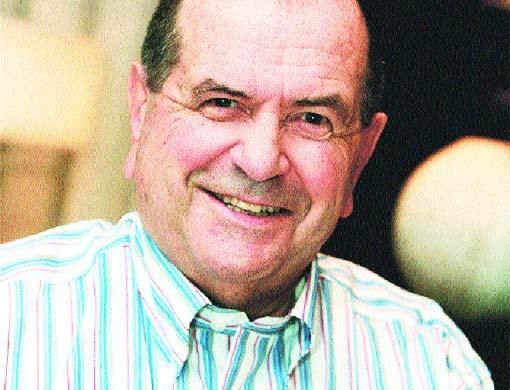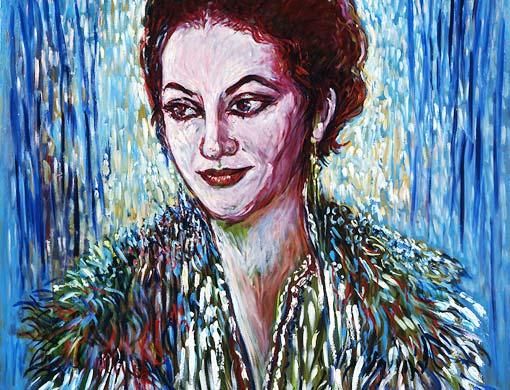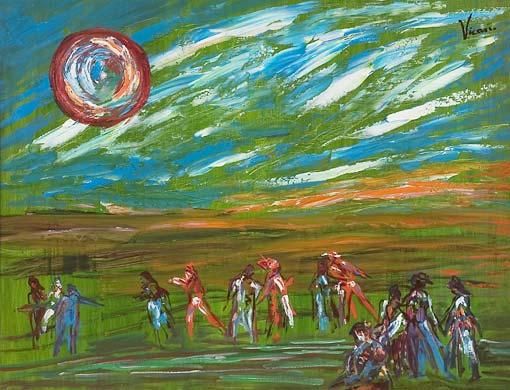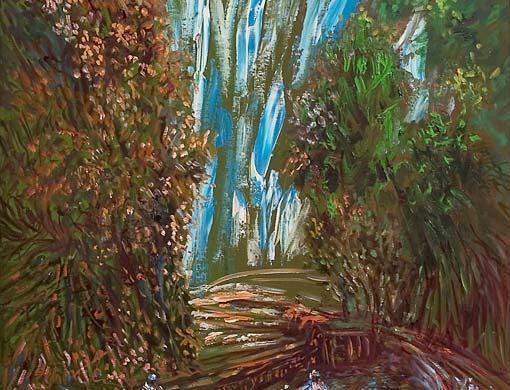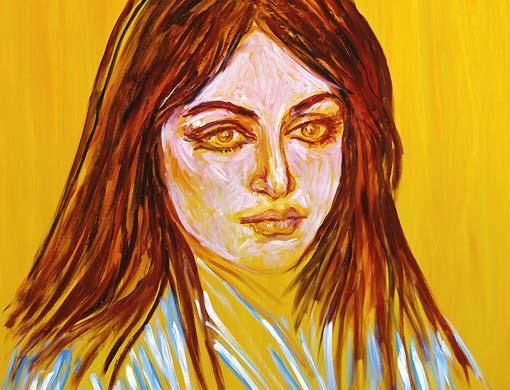Andrew Vicari appears much mellower since the last time we met. He is in fact, by his own admission, more guarded. "Too many interviews and too many incidents of my words taken out of context," he says.
Though he still insists that the best people to spend an evening with are journalists. "And the French police," he adds. And Vicari would know them fairly well — purely in the capacity of being the official painter of Interpol and France's Companies for Republican Security.
"While painting, one already has to spend all this time locked up with one's demons, the world's demons and whatever else. The last thing I want to be doing is going out with other painters and intellectuals. Go out with journalists and the police and you'll have a great time," he says.
Vicari, who is listed as the world's highest paid artist, will be in Dubai for a month.
"That's for destiny to decide, not The Sunday Times," he says in response to his fee.
Despite his education at London's Slade School of Fine Art and the blessing of Francis Bacon, Vicari recalls that nobody wanted to host his first show.
"Bacon was a marvellous man. He tried to get me a show in the late fifties, but was turned down," he says, drifting into yet another anecdote from his life.
Pinning down Vicari to a subject and thought is a daunting task, whether it is recalling how he almost became Albert Einstein's relative. "I used to date his grand-niece."
Or the influence of Balenciaga on his life. "I must have made love to 50 women that wore him."
And his first — and last — meeting with Frank Sinatra. "We met at the urinals."
Vicari is opinionated — highly, in fact. And though he offers it freely, this time round he almost always winds it up with a "there I go again. I don't know what this is going to get printed as".
He has, he says, enjoyed life. And there have been some remarkable influences, encounters and experiences.
In fact, his exhibition of 50 iconic figures of the 20th century could be interpreted as Vicari's homage to them.
"It's a chicken and egg situation," he says of what came first — the paintings or the concept note for the exhibition.
After much deliberation, it seems that the event was agreed on and then he started painting.
"The funny thing is I began with Ravi Shankar [the Indian musician] and ended with him. I even bent his guitar [sic]," he says, then correcting himself on receiving puzzled looks.
"Sitar? Is that it?" Musicians and poets feature prominently in Vicari's tribute, though he confesses to playing "cheap music" while actually painting.
His peak time is around three in the afternoon after which the closer it gets to six, it all goes downhill.
Vicari won't comment on whether he is worth the enormous amounts of money he charges.
The famous ego itself has also been tamed, though it does surface in an endearing manner as if to reassure that Vicari hasn't changed. Too much.
"I have a little ego. I think the difference between good and great art is the elimination of as much as possible ego in the work," he says.
"There are still moments when I see a pavement artist and I get blown away by their talent. So my ego doesn't inflate as much," he laughs. Why then is he perceived as having a super-ego?
"Well, that's their problem," he retorts. Vintage Vicari.
And, he clarifies, it is a complete myth that he paints only famous people.
"Putin is a great friend, I've never painted him."
But a glance through his portraits of iconic figures — that includes Ella Fitzgerald, Walt Disney, Walt Whitman, Fayrouz and Umm Kalthoum — is a veritable visual feast of a who's who of heavyweight talent.
"The face is a mirror of the soul. When I paint, I penetrate through to that soul and bring out what I read of the face," he says.
In his 53 icons, it was the visages of Rabindranath Tagore that captivated him the most.
"It just shot out at me. Also Pavarotti. I finished that in five brush strokes," he says. And how can he forget W.H. Auden. "His face is like three Grand Canyons."
It is the uncertainty and indiscipline in the lines that attracts Vicari to faces and the less clearly defined they are, the more he loves it.
Apart from the odd, odd, theory that he tosses up, Vicari generally steers clear of voicing political opinion, though it does slip out on a couple of occasions.
"Whitman's America is very different from Bush's America. America has done a lot of harm, but I don't want to get into politics now," he says.
Catching him on the thought, it had to be asked what Vicari thought about the rhetoric on dialogue between civilisations.
Having painted many rulers of the West, he knows his views would be welcome.
"There's always been a dialogue. For the past 2,000 years. I just think there's too much political correctness now and I refuse to listen to the news. It's biased, especially TV. And unless it's an assassination or something, major, I probably already know it anyway."
The Vicari itinerary
Iconic figures: From November 1–30 at the Dubai Community Theatre and Arts Centre.
Lecture: The Thoughts of Maitre Andrew Vicari on the "Resurrection and Re-emergence of Fine Art in the 21st Century: The Big Sleep & New Frontiers" on November 3 at the Dubai Community Theatre & Arts Centre at 7pm.
Retrospective: The Vicari Enigmas: A Retrospective Exhibition of Paintings and Drawings by Andrew Vicari 1956-2006. From November 4-7 at the Exhibition Grand Ballroom, Grosvenor House.
Master class: Andrew Vicari's Master Class
From November 5-9 at the Dubai Community Theatre and Arts Centre.
Contact: Dubai Community Theatre and Arts Centre on 04-3414777; Grosvenor House on 04-3998888
Soul portrayal
Soul portrayal


